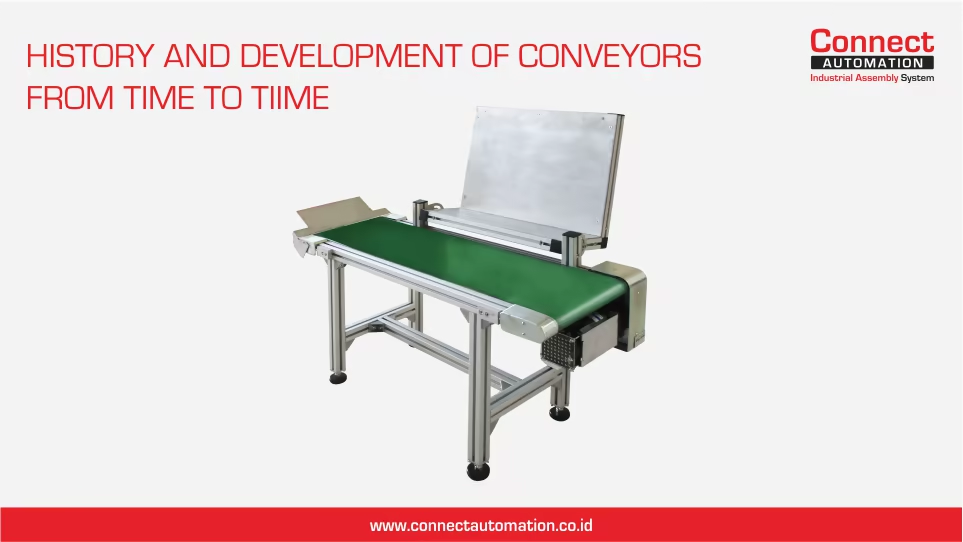History and Development of Conveyors from Time to Time

The invention of the conveyor has revolutionized industry around the world, simplifying production processes and increasing efficiency. To understand the impact of this incredible invention, let's delve into its history and how conveyors have evolved over time.
The Beginning of the History of Conveyors
Conveyors are a technology that has become an important part of modern industry. The history of conveyors begins in the 18th century, when humans first started using simple tools to move goods automatically. The concept of transporting goods dates back centuries, with early civilizations using simple methods such as ropes and pulleys to transport materials. One of the important milestones in the history of conveyors was made by Richard Sutcliffe, an English mining engineer who patented the first conveyor belt in 1795 also known as "mining conveyor". Sutcliffe's invention consisted of a wooden frame and leather belt that allowed the efficient transportation of coal and other materials within the mine. Initially, conveyors were used mainly in the mining and agricultural industries to move coal, ore and crops more efficiently. However, as time went by, the use of conveyors expanded to various other industrial sectors such as manufacturing, logistics and distribution. The history of conveyors began in the 17th century, when the conveyor system was first invented. Initially, conveyors were used to facilitate the transportation of goods along certain routes. However, in its development, conveyors have experienced many innovations and technological improvements.
Conveyor Development
Over time, a simple conveyor system was discovered to be used to move goods with the help of human or animal power. However, with technological developments in the 19th and 20th centuries, machines began to be used to move conveyors automatically. As industrialization gained momentum in the 19th century, conveyors became increasingly important in a variety of industries. In 1901, the Swedish engineering company Sandvik AB introduced the steel belt, marking a significant advance in conveyor technology. This innovation increases durability and load-carrying capacity, paving the way for wider industrial applications. Conveyors continue to develop along with advances in technology. The introduction of motorized systems in the early 20th century further increased their capabilities and efficiency. Today, we witness a range of specialized conveyors tailored to specific industries such as manufacturing, logistics and food processing. From labor-intensive manual operations to automated systems driven by robotics and artificial intelligence (AI), conveyors have played a critical role in shaping modern industrial processes. This technology enables faster production cycles, reduces labor costs, improves safety standards, and facilitates seamless material handling on a large scale.
First Belt Conveyor
Then in 1892, Thomas Robins created the first conveyor belt made of canvas or rubber. This innovation enables more efficient and faster transportation of materials in the mining industry. Because the belt material used has safer flexibility, it can increase effectiveness in the industrial world at that time. Thanks to his invention, he managed to win the main prize at the Paris Exposition World Fair in 1900. Furthermore, in 1905, Richard Sutcliffe created a portable stone crushing machine that used a conveyor system made of cotton and rubber to transport crushed stones. This helps increase productivity in the construction industry, which previously had to be done manually, and can then be done efficiently without having to use a lot of energy. During World War II, the use of conveyor systems became increasingly widespread in various industrial sectors such as automotive and electronics. Conveyors are used to move vehicle components or electronic products from one production stage to the next with high efficiency because at that time they require quite a lot of time efficiency so conveyors are considered the right solution for moving goods from the initial place to the next location. others without having to worry about the energy expended. In the last few decades, technological developments have continued to drive innovation in the design and function of conveyor systems. Currently there are various types of conveyors available such as roller conveyors, belt conveyors, gravity conveyors, and others. Each type has different advantages and uses according to various industrial needs.
Conclusion
Thus, the history of conveyors shows how this technology has significantly changed the way goods are produced and distributed. In its development, conveyors continue to be an important element in modern industry that allows the movement of materials with high efficiency and speed.
Connect Automation specializes in providing automation solutions, including conveyor systems, to improve efficiency across various industries. The company delivers cutting-edge technology to help organizations automate tasks and optimize workflows. Connect Automation helps businesses reduce manual efforts, boost productivity, and achieve better outcomes. With a customer-focused approach, the company designs tailored solutions to ensure smooth and effective automation transitions for long-term success.
Kawasan Industri Jababeka Tahap 1, Jl. Jababeka II D Blok C14L Cikarang, Indonesia (17530)
(021) 893 5060 Google Maps
Rungkut Industri III, No. 37, Rungkut Menanggal, Kec. Gn. Anyar Surabaya, Indonesia (60293)
(031) 9985 8624 Google Maps
